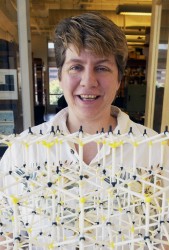Vanderbilt Research Brightens the Future of Lighting
by David Salisbury
With the age of the incandescent light bulb fading rapidly, the holy grail of the lighting industry is to develop a highly efficient form of solid-state lighting that produces high quality white light.
 One of the few alternative technologies that produce pure white light is white-light quantum dots. These are ultra-small fluorescent beads of cadmium selenide that can convert the blue light produced by an LED into a warm white light with a spectrum similar to that of incandescent light. (By contrast, compact fluorescent tubes and most white-light LEDs emit a combination of monochromatic colors that simulate white light).
One of the few alternative technologies that produce pure white light is white-light quantum dots. These are ultra-small fluorescent beads of cadmium selenide that can convert the blue light produced by an LED into a warm white light with a spectrum similar to that of incandescent light. (By contrast, compact fluorescent tubes and most white-light LEDs emit a combination of monochromatic colors that simulate white light).
Seven years ago, when white-light quantum dots were discovered accidentally in a Vanderbilt chemistry lab, their efficiency was too low for commercial applications and several experts predicted that it would be impossible to raise it to practical levels. Today, however, Vanderbilt researchers have proven those predictions wrong by reporting that they have successfully boosted the fluorescent efficiency of these nanocrystals from an original level of three percent to as high as 45 percent.
You can read more about Quantum Dots here at Vanderbilt’s Research News Page.

Leave a Response